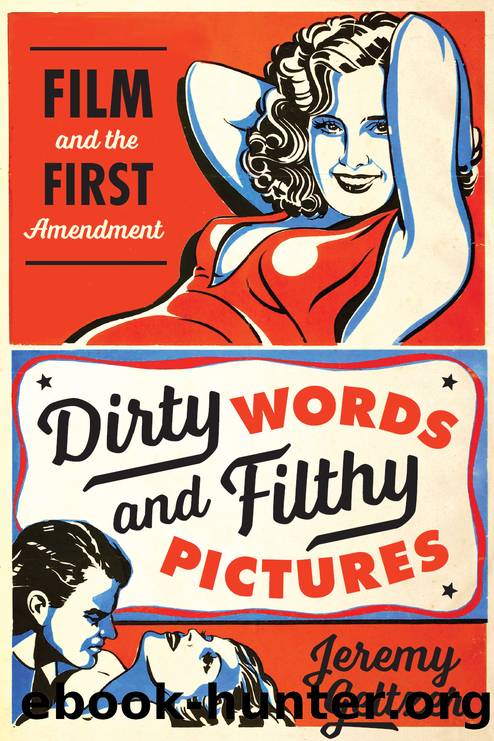Dirty Words and Filthy Pictures by Jeremy Geltzer

Author:Jeremy Geltzer [Geltzer, Jeremy]
Language: eng
Format: epub
Publisher: University of Texas Press
Published: 2015-08-14T16:00:00+00:00
The sex Western The Ramrodder (1969) included two future Manson-family members in its cast.
After receiving a complaint about Motel Confidential, a police officer visited the theater and watched the film. Once the credits rolled, he returned to his desk and dutifully applied for a warrant, which the magistrate issued—no questions asked and without seeing the picture. The officer returned to seize posters and film print and to arrest the theater’s owner.34 The theater owner argued the warrant was invalid: the magistrate issued the warrant without viewing the film, and no adversarial proceeding was held to consider the picture’s alleged obscenity. The court denied the theater’s claim, finding the officer’s detailed summary of the film sufficient for the magistrate’s reliance. Based on the description, “the film and photographs were probably obscene,” wrote the court, which found “that the issuance of the warrant . . . did not constitute either a prior restraint on communications, a denial of due process, or a violation of constitutional seizure provisions.”35
Law enforcement techniques varied. Authorities in North Carolina and St. Louis could not be bothered by procedural formalities before seizing motion pictures. Other authorities at least went through the motions, even if validity of the warrant was dubious.
In State v. Eros Cinema, Inc. (1972), Louisiana authorities superficially complied with the procedural formalities. Eros Cinema centered on the seizure of several films, including Four Women in Trouble, Studs Galore, and Zodiaction. Four Women in Trouble (1970) featured legendary performer John Holmes playing an abortion doctor in one of his first credited performances; no information is available regarding the other films. Rather than discussing any issues of content relating to possible obscenity in the program, the focus of Eros Cinema was the validity of the warrant.
Looking to the Supreme Court for guidance, Louisiana cited Quantity of Books v. Kansas (1964), in which the High Court held that the seizure of materials prior to an adversarial determination of obscenity was unconstitutional. Without reaching the question of whether the novels at issue were legally obscene, the Court found that the issuance of a warrant prior to an obscenity hearing was unconstitutional.36
Differentiating Eros Cinema from Quantity of Books, the Louisiana court attempted to circumvent procedure by citing legal needs: “We hold that the seizure of a single copy of an allegedly obscene motion picture . . . may be had without a prior adversary hearing. . . . If a person is in fact exhibiting an obscene film, notice to the exhibitor that he is required to appear in court for a hearing to determine whether the film might be seized as evidence affords him an opportunity to destroy the evidence of his crime.”37 Despite Freedman, which placed the burden on regulators to mandate prompt judicial determination prior to any declaration of a film’s obscenity, Louisiana rationalized the warrantless seizure of offending motion pictures under the pretext of preserving evidence.
In Virginia a similar episode occurred. The Lee Art Theatre was showing A Smell of Honey, a Swallow of Brine (1966). This
Download
This site does not store any files on its server. We only index and link to content provided by other sites. Please contact the content providers to delete copyright contents if any and email us, we'll remove relevant links or contents immediately.
| Anthropology | Archaeology |
| Philosophy | Politics & Government |
| Social Sciences | Sociology |
| Women's Studies |
Cecilia; Or, Memoirs of an Heiress — Volume 1 by Fanny Burney(32413)
Cecilia; Or, Memoirs of an Heiress — Volume 3 by Fanny Burney(31825)
Cecilia; Or, Memoirs of an Heiress — Volume 2 by Fanny Burney(31814)
The Great Music City by Andrea Baker(31252)
We're Going to Need More Wine by Gabrielle Union(18952)
All the Missing Girls by Megan Miranda(15505)
Pimp by Iceberg Slim(14328)
Bombshells: Glamour Girls of a Lifetime by Sullivan Steve(13954)
Talking to Strangers by Malcolm Gladwell(13196)
Norse Mythology by Gaiman Neil(13177)
Fifty Shades Freed by E L James(13146)
For the Love of Europe by Rick Steves(12676)
Mindhunter: Inside the FBI's Elite Serial Crime Unit by John E. Douglas & Mark Olshaker(9164)
Crazy Rich Asians by Kevin Kwan(9148)
The Lost Art of Listening by Michael P. Nichols(7389)
Enlightenment Now: The Case for Reason, Science, Humanism, and Progress by Steven Pinker(7176)
The Four Agreements by Don Miguel Ruiz(6603)
Bad Blood by John Carreyrou(6523)
Weapons of Math Destruction by Cathy O'Neil(6117)
